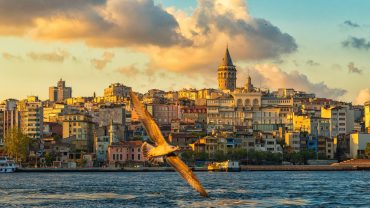Autonomous Republics : Abkhazia, Adjara Regions :
 Tbilisi (capital), Guria, Imereti, Kakheti, Kvemo Kartli, Mtskheta-Mtianeti, Racha-Lechkhumi and Kvemo Svaneti, Samegrelo-Zemo Svaneti, Samtskhe-Javakheti, Shida Kartli. Georgia (Georgian: საქართველო, romanized: sakartvelo; IPA: [sɑkʰɑrtʰvɛlɔ] (About this soundlisten)) is a transcontinental country in the Caucasus region of Eurasia. Located at the crossroads of Western Asia and Eastern Europe, it is bounded to the west by the Black Sea, to the north by Russia, to the east by Azerbaijan, and to the south by Armenia and Turkey. The capital and largest city is Tbilisi. Georgia covers a territory of 69,700 square kilometres (26,911 sq mi), and its approximate population is about 3.718 million. Georgia is a unitary parliamentary republic, with the government elected through a representative democracy. During the classical era, several independent kingdoms became established in what is now Georgia, such as Colchis and Iberia. The Georgians officially adopted Christianity in the early 4th century. The Georgian Orthodox Church had enormous importance for the spiritual and political unification of early Georgian states. The unified Kingdom of Georgia reached its Golden Age during the reign of King David the Builder and Queen Tamar the Great in the 12th and early 13th centuries. Thereafter, the kingdom declined and eventually disintegrated under the hegemony of various regional powers, including the Mongols, the Ottoman Empire and successive dynasties of Iran. In the late 18th century, the eastern Georgian Kingdom of Kartli-Kakheti forged an alliance with the Russian Empire, which directly annexed the kingdom in 1801 and conquered the western Kingdom of Imereti in 1810. Russian rule over Georgia was eventually acknowledged in various peace treaties with Iran and the Ottomans and the remaining Georgian territories were absorbed by the Russian Empire in a piecemeal fashion through the course of the 19th century. During the Civil War following the Russian Revolution in 1917, Georgia briefly became part of the Transcaucasian Federation[11] and then emerged as an independent republic before the Russian army invasion in 1921, which established a government of workers’ and peasants’ soviets. Soviet Georgia was incorporated into a new Transcaucasian Federation and became a founding republic of the Soviet Union in 1922. In 1936, the Transcaucasian Federation was dissolved and Georgia emerged as a Union Republic. During World War II, almost 700,000 Georgians fought in the Red Army against the Germans. After Soviet leader Joseph Stalin, a native Georgian, died in 1953, a wave of protest spread against Nikita Khrushchev and his de-Stalinization reforms, leading to the death of nearly one hundred students in 1956. By the 1980s, an independence movement was established and grew, leading to Georgia’s secession from the Soviet Union in April 1991. For most of the following decade, post-Soviet Georgia suffered from civil conflicts, secessionist wars in Abkhazia and South Ossetia, and economic crisis. Following the bloodless Rose Revolution in 2003, Georgia strongly pursued a pro-Western foreign policy; aimed at NATO and European integration, it introduced a series of democratic and economic reforms. This brought about mixed results, but strengthened state institutions. The country’s Western orientation soon led to the worsening of relations with Russia, culminating in the brief Russo-Georgian War in August 2008 and Georgia’s current territorial dispute with Russia. Georgia is a developing country and ranks 61st on the Human Development Index. The country is a member of the United Nations, the Council of Europe, and the GUAM Organization for Democracy and Economic Development. It contains two de facto independent regions, Abkhazia and South Ossetia, which gained very limited international recognition after the 2008 Russo-Georgian War. Most of the world’s countries consider the regions to be Georgian territory under Russian occupation.
Tbilisi (capital), Guria, Imereti, Kakheti, Kvemo Kartli, Mtskheta-Mtianeti, Racha-Lechkhumi and Kvemo Svaneti, Samegrelo-Zemo Svaneti, Samtskhe-Javakheti, Shida Kartli. Georgia (Georgian: საქართველო, romanized: sakartvelo; IPA: [sɑkʰɑrtʰvɛlɔ] (About this soundlisten)) is a transcontinental country in the Caucasus region of Eurasia. Located at the crossroads of Western Asia and Eastern Europe, it is bounded to the west by the Black Sea, to the north by Russia, to the east by Azerbaijan, and to the south by Armenia and Turkey. The capital and largest city is Tbilisi. Georgia covers a territory of 69,700 square kilometres (26,911 sq mi), and its approximate population is about 3.718 million. Georgia is a unitary parliamentary republic, with the government elected through a representative democracy. During the classical era, several independent kingdoms became established in what is now Georgia, such as Colchis and Iberia. The Georgians officially adopted Christianity in the early 4th century. The Georgian Orthodox Church had enormous importance for the spiritual and political unification of early Georgian states. The unified Kingdom of Georgia reached its Golden Age during the reign of King David the Builder and Queen Tamar the Great in the 12th and early 13th centuries. Thereafter, the kingdom declined and eventually disintegrated under the hegemony of various regional powers, including the Mongols, the Ottoman Empire and successive dynasties of Iran. In the late 18th century, the eastern Georgian Kingdom of Kartli-Kakheti forged an alliance with the Russian Empire, which directly annexed the kingdom in 1801 and conquered the western Kingdom of Imereti in 1810. Russian rule over Georgia was eventually acknowledged in various peace treaties with Iran and the Ottomans and the remaining Georgian territories were absorbed by the Russian Empire in a piecemeal fashion through the course of the 19th century. During the Civil War following the Russian Revolution in 1917, Georgia briefly became part of the Transcaucasian Federation[11] and then emerged as an independent republic before the Russian army invasion in 1921, which established a government of workers’ and peasants’ soviets. Soviet Georgia was incorporated into a new Transcaucasian Federation and became a founding republic of the Soviet Union in 1922. In 1936, the Transcaucasian Federation was dissolved and Georgia emerged as a Union Republic. During World War II, almost 700,000 Georgians fought in the Red Army against the Germans. After Soviet leader Joseph Stalin, a native Georgian, died in 1953, a wave of protest spread against Nikita Khrushchev and his de-Stalinization reforms, leading to the death of nearly one hundred students in 1956. By the 1980s, an independence movement was established and grew, leading to Georgia’s secession from the Soviet Union in April 1991. For most of the following decade, post-Soviet Georgia suffered from civil conflicts, secessionist wars in Abkhazia and South Ossetia, and economic crisis. Following the bloodless Rose Revolution in 2003, Georgia strongly pursued a pro-Western foreign policy; aimed at NATO and European integration, it introduced a series of democratic and economic reforms. This brought about mixed results, but strengthened state institutions. The country’s Western orientation soon led to the worsening of relations with Russia, culminating in the brief Russo-Georgian War in August 2008 and Georgia’s current territorial dispute with Russia. Georgia is a developing country and ranks 61st on the Human Development Index. The country is a member of the United Nations, the Council of Europe, and the GUAM Organization for Democracy and Economic Development. It contains two de facto independent regions, Abkhazia and South Ossetia, which gained very limited international recognition after the 2008 Russo-Georgian War. Most of the world’s countries consider the regions to be Georgian territory under Russian occupation.
Music
Georgia has an ancient musical tradition, which is primarily known for its early development of polyphony. Georgian polyphony is based on three vocal parts, a unique tuning system based on perfect fifths, and a harmonic structure rich in parallel fifths and dissonances.[citation needed] Three types of polyphony have developed in Georgia: a complex version in Svaneti, a dialogue over a bass background in the Kakheti region, and a three-part partially-improvised version in western Georgia. The Georgian folk song “Chakrulo” was one of 27 musical compositions included on the Voyager Golden Records that were sent into space on Voyager 2 on 20 August 1977
Cuisine
Georgian cuisine and wine have evolved through the centuries, adapting traditions in each era. One of the most unusual traditions of dining is supra, or Georgian table, which is also a way of socialising with friends and family. The head of supra is known as tamada. He also conducts the highly philosophical toasts, and makes sure that everyone is enjoying themselves. Various historical regions of Georgia are known for their particular dishes: for example, khinkali (meat dumplings), from eastern mountainous Georgia, and khachapuri, mainly from Imereti, Samegrelo and Adjara. In addition to traditional Georgian dishes, the foods of other countries have been brought to Georgia by immigrants from Russia, Greece, and recently China.

Prehistory The territory of modern-day Georgia was inhabited by Homo erectus since the Paleolithic Era. The proto-Georgian tribes first appear in written history in the 12th century BC. The earliest evidence of wine to date has been found in Georgia, where 8,000-year old wine jars were uncovered. Archaeological finds and references in ancient sources also reveal elements of early political and state formations characterized by advanced metallurgy and goldsmith techniques that date back to the 7th century BC and beyond. In fact, early metallurgy started in Georgia during the 6th millennium BC, associated with the Shulaveri-Shomu culture. Antiquity The classical period saw the rise of a number of early Georgian states, the principal of which were Colchis in the west and Iberia in the east. In Greek mythology, Colchis was the location of the Golden Fleece sought by Jason and the Argonauts in Apollonius Rhodius’ epic tale Argonautica. The incorporation of the Golden Fleece into the myth may have derived from the local practice of using fleeces to sift gold dust from rivers. In the 4th century BC, a kingdom of Iberia – an early example of advanced state organization under one king and an aristocratic hierarchy – was established. After the Roman Republic completed its brief conquest of what is now Georgia in 66 BC, the area became a primary objective of what would eventually turn out to be over 700 years of protracted Irano–Roman geo-political rivalry and warfare. From the first centuries A.D, the cult of Mithras, pagan beliefs, and Zoroastrianism were commonly practised in Georgia. In 337 AD King Mirian III declared Christianity as the state religion, giving a great stimulus to the development of literature, arts, and ultimately playing a key role in the formation of the unified Georgian nation, The acceptance led to the slow but sure decline of Zoroastrianism, which until the 5th century AD, appeared to have become something like a second established religion in Iberia (eastern Georgia), and was widely practised there. Middle Ages up to early modern period Located on the crossroads of protracted Roman–Persian wars, the early Georgian kingdoms disintegrated into various feudal regions by the early Middle Ages. This made it easy for the remaining Georgian realms to fall prey to the early Muslim conquests in the 7th century. Kingdom of Abkhazia An Arab incursion into western Georgia led by Marwan II, was repelled by Leon I (r.720–740) jointly with his Lazic and Iberian allies in 736. Leon I then married Mirian’s daughter, and a successor, Leon II exploited this dynastic union to acquire Lazica in the 770s. The successful defense against the Arabs, and new territorial gains, gave the Abkhazian princes enough power to claim more autonomy from the Byzantine Empire. Towards circa 778, Leon II (r.780–828) won his full independence with the help of the Khazars and was crowned as the king of Abkhazia. After obtaining independence for the state, the matter of church independence became the main problem. In the early 9th century the Abkhazian Church broke away from the Constantinople and recognized the authority of the Catholicate of Mtskheta; Georgian language replaced Greek as the language of literacy and culture. The most prosperous period of the Abkhazian kingdom was between 850 and 950. A bitter civil war and feudal revolts which began under Demetrius III (r. 967–975) led the kingdom into complete anarchy under the unfortunate king Theodosius III the Blind (r. 975–978). A period of unrest ensued, which ended as Abkhazia and eastern Georgian states were unified under a single Georgian monarchy, ruled by King Bagrat III of Georgia (r. 975–1014), due largely to the diplomacy and conquests of his energetic foster-father David III of Tao (r. 966–1001).





Comment (0)